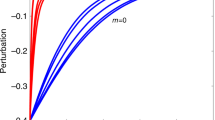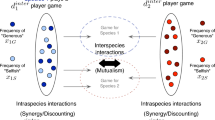Summary
Most previous analyses of the stability properties of models of mutualism have emphasized the destabilizing effects of mutualism. However, these analyses can be shown to be based upon inappropriate assumptions, or to be applicable only for special cases of mutualism. In this paper three basic 2-species models of mutualism are presented and their six combinations are analyzed by computer simulation for their return time stability and persistence stability. Four out of six models show greater return time stability than an appropriate model without mutualism, and all models show higher persistence stability than the model without mutualism. It is argued that real biological systems can be related to the qualitative structure of each of the basic models of mutualism, and that therefore none of the basic models or their stability properties can be eliminated a priori as being inappropriate. The conclusion follows that while some kinds of mutualistic interactions may be relatively unstable, other mutualisms, probably representing the majority of cases, can be considered to be relatively stable. The limitations of these models and analyses are considered.
Similar content being viewed by others
References
Addicott JF (1979) A multispecies aphid-ant association: density dependence and species-specific effects. Can J Zool 57:558–569
Brown JH, Kodric-Brown A (1979) Covergence, competition, and mimicry in a temperate community of hummingbird-pollinated flowers. Ecology 60:1022–1035
Christiansen FB, Fenchel TM (1977) Theories of Populations in Biological Communities. Berlin Heidelberg New York: Springer
Colwell RK, Fuentes E (1975) Experimental studies of the niche. Annu Rev Ecol Syst 6:281–310
Farnworth EG, Golley FB (1974) Fragile Ecosystems: Evaluation of Research and Applications in the Neotrophics. Berlin Heidelberg New York: Springer
Gause GF, Witt AA (1935) Behaviour of mixed populations and the problem of natural selection. Amer Natur 69:596–609
Goh BS (1979) Stability in models of mutualism. Amer Natur 113:261–275
Harley JL (1970) The improtance of micro-organisms to colonizing plants. Trans Bot Soc Edinb 41:65–70
Holling CS (1973) Resilience and stability of ecological systems. Annu Rev Ecol Syst 4:1–23
Janzen DH (1967) Fire, vegetation structure, and the ant x acacia interaction in Central America. Ecology 48:26–35
Levins R (1974) The qualitative analysis of partially specified systems. Ann NY Acad Sci 231:123–138
Lewis DH (1973) The relevance of symbiosis to taxonomy and ecology, with particular reference to mutualistic symbioses and the exploitation of marginal habitats. In: VH Heywood (ed), Taxonomy and Ecology. Academic Press London p 151–172
May RM (1973a) Qualitative stability in model ecosystems. Ecology 54:638–641
May RM (1973b) Stability and Complexity in Model Ecosystems. Princeton, New Jersey: Princeton University Press
May RM (1975) Stability in ecosystems: Some comments. In: WH van Dobben and RH Lowe-McConnell (eds), Unifying Concepts in Ecology. Dr W Junk BV Publishers The Hague pp 161–168
May RM (1976) Models for two interacting populations. In: RM May (ed), Theoretical Ecology. WB Saunders Co Philadelphia pp 49–70
Pielou EC (1977) Mathematical Ecology. John Wiley and Sons New York
Risch S, Boucher DH (1976) What ecologists look for. Bull Ecol Soc Amer 57(3):8–9
Starr MP (1974) A generalized scheme for classifying organismic associations. Symp Soc Exp Biol 29:1–20
Travis CC, Post WM (1979) Dynamics and comparative statics of mutualistic communities. J Theor Biol 78:553–571
Vance RR (1978) A mutualistic interaction between a sessile marine clam and its epibionts. Ecology 59:679–685
Vandermeer JH, Boucher DH (1978) Varieties of mutualistic interaction in population models. J Theor Biol 74:549–558
Whittaker RH (1975) Communities and Ecosystems. 2nd Edition. Mac-Millan Publishing Co. Inc New York
Williamson M (1972) The Analysis of Biological Populations. Edward Arnold (Publishers) Ltd. London
Wilson DS (1980) The Natural Selection of Populations and Communities. Menlo Park, California: The Benjamin/Cummings Publishing Company, Inc.
Author information
Authors and Affiliations
Rights and permissions
About this article
Cite this article
Addicott, J.F. Stability properties of 2-species models of mutualism: Simulation studies. Oecologia 49, 42–49 (1981). https://doi.org/10.1007/BF00376896
Received:
Issue Date:
DOI: https://doi.org/10.1007/BF00376896




